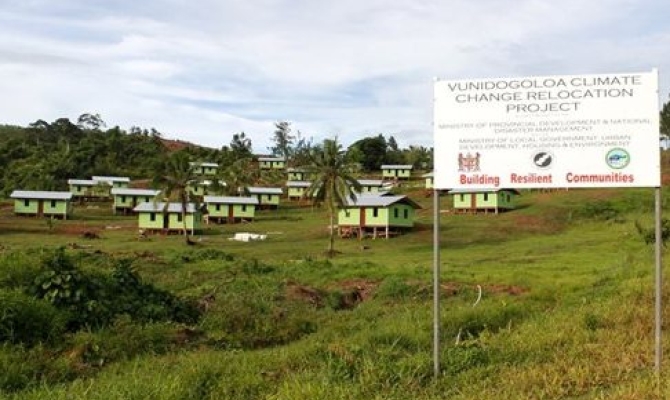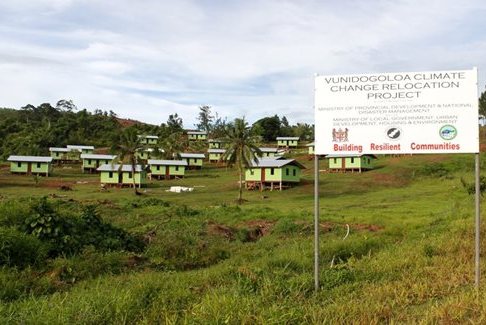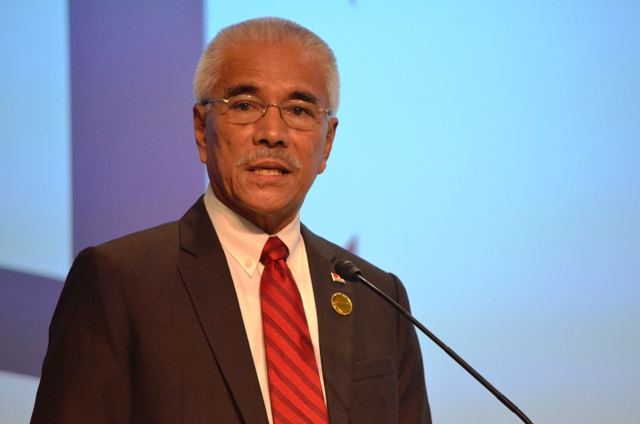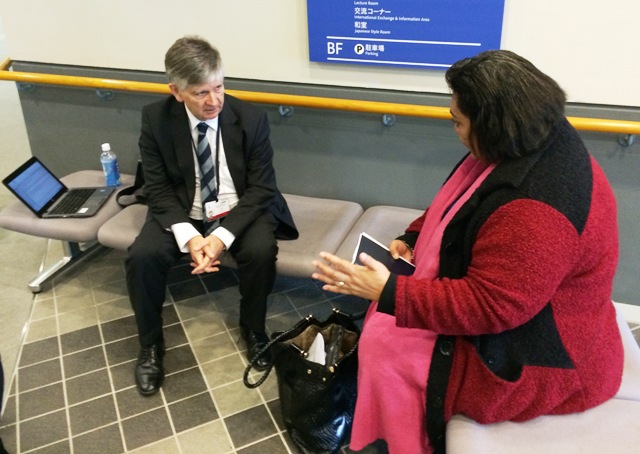
Climate Change Resilience
Human mobility and displacement in the context of natural disasters and the effects of climate change were relevant in a range of different paragraphs within the newly endorsed Sendai Framework for Disaster Risk Reduction 2015 – 2030.
The new Sendai Framework is the outcome of the Third UN World Conference on Disaster Risk Reduction hosted in Sendai, Japan from 14 – 18 March this year.
The overall goal of the Nansen Initiative, launched in 2012 by Switzerland and Norway, is to build understanding and consensus among States on key principles and elements of a Protection Agenda to address the needs of people displaced across borders in the context of disasters and the negative effects of climate change.

Hosting a special event on the sidelines of the 3WCDRR on Displacement and the Post-2015 Framework for Disaster Risk Reduction, experiences were shared from different regions. Cross-border movements of pastoralists in the Horn of Africa; Migration as a resilience building measure in the Hindukush Himalaya region; And the integration of human mobility into regional disaster risk reduction frameworks from the Pacific.
"Displacement linked to disasters is a reality. It will grow, and it has devastating consequences on people's lives. It is an issue that has to be addressed, not discussed," said Prof. Walter Kaelin, Envoy of the Chairmanship of the Nansen Initiative. "And then we can move forward, include it in national policies, disaster risk reduction plans, and the real work starts".
During the Nansen Initiative Pacific Regional Consultation co-hosted by the Secretariat of the Pacific Regional Environment Programme (SPREP) in May 2013, participants acknowledged that as a consequence of sea level rise, acidification and extreme weather patterns, voluntary migration, planned relocation and displacement are expected to rise significantly in the next decades and beyond. While such population movements primarily take place within the borders of Pacific countries, some are already cross-border in nature.
Displacement describes forced movements of people while migration is used for voluntary movements. To use migration as a means to adapt to the effects of climate change before people are actually forced to move has been raised as a consideration for the island nation of Kiribati.
 H.E President Anote Tong, addressing the High Level Plenary at the 3WCDRR in Sendai, Japan
H.E President Anote Tong, addressing the High Level Plenary at the 3WCDRR in Sendai, Japan
H.E President Anote Tong addressed the Third UN World Conference on Disaster Risk Reduction, highlighting the link between climate change and disasters, asking where his people will be if their homes are eaten away by waves.
"We are fighting to save our land, the land of our ancestors so that our children and children's children have their own country where they can enjoy the right to be free citizens with the ability to make choices, "said President Tong.
"Failing that, let us empower our people to make a choice – to stay and take a risk or migrate to higher grounds where we stand a better chance of survival because for us from low lying atoll nations we sadly do not have that choice in our countries despite our efforts to adapt – the choice of relocating to higher ground has been focused mainly beyond our borders."
The Nansen Initiative seeks to build consensus on elements of a Protection Agenda based on three pillars: international cooperation and solidarity; standards for the treatment of affected people regarding admission, stay, status; and operational responses including funding mechanisms and responsibilities of international humanitarian and development actors.
Dr Netatua Pelesikoti, Director of SPREP Climate Change Division contributed to the side event by explaining the role of SPREP in partnership with the Nansen Initiative in facilitating the discourse on population movements in the context of disasters and climate change. She pointed out that for many Pacific island countries and territories, population displacement could be the very last strategy considered. People do not want to leave their island.

As a follow-up to the Regional Consultation on Human Mobility, Disasters and Climate Change in the Pacific held in Rarotonga, Cook Islands in 2013, SPREP and the Nansen Initiative formed a partnership. A Civil Society Meeting also took place in Suva, Fiji in August 2014.
In order to directly participate in the Nansen Initiative process, SPREP is also hosting a Nansen Initiative Secondee who promotes and advocates for the issue among governments and regional organisations in the Pacific.
For more information on the Nansen Initiative please email Mr. Ewan Cameron, Nansen Initiative Secondee at SPREP
The new Sendai Framework is the outcome of the Third UN World Conference on Disaster Risk Reduction hosted in Sendai, Japan from 14 – 18 March this year.
The overall goal of the Nansen Initiative, launched in 2012 by Switzerland and Norway, is to build understanding and consensus among States on key principles and elements of a Protection Agenda to address the needs of people displaced across borders in the context of disasters and the negative effects of climate change.

Vunidogoloa Climate Change Relocation Project opened in 2014, Vunidogoloa a village in Fiji was relocated in 2014. Image courtesy of the Fiji Government Online Portal
Hosting a special event on the sidelines of the 3WCDRR on Displacement and the Post-2015 Framework for Disaster Risk Reduction, experiences were shared from different regions. Cross-border movements of pastoralists in the Horn of Africa; Migration as a resilience building measure in the Hindukush Himalaya region; And the integration of human mobility into regional disaster risk reduction frameworks from the Pacific.
"Displacement linked to disasters is a reality. It will grow, and it has devastating consequences on people's lives. It is an issue that has to be addressed, not discussed," said Prof. Walter Kaelin, Envoy of the Chairmanship of the Nansen Initiative. "And then we can move forward, include it in national policies, disaster risk reduction plans, and the real work starts".
During the Nansen Initiative Pacific Regional Consultation co-hosted by the Secretariat of the Pacific Regional Environment Programme (SPREP) in May 2013, participants acknowledged that as a consequence of sea level rise, acidification and extreme weather patterns, voluntary migration, planned relocation and displacement are expected to rise significantly in the next decades and beyond. While such population movements primarily take place within the borders of Pacific countries, some are already cross-border in nature.
Displacement describes forced movements of people while migration is used for voluntary movements. To use migration as a means to adapt to the effects of climate change before people are actually forced to move has been raised as a consideration for the island nation of Kiribati.
 H.E President Anote Tong, addressing the High Level Plenary at the 3WCDRR in Sendai, Japan
H.E President Anote Tong, addressing the High Level Plenary at the 3WCDRR in Sendai, JapanH.E President Anote Tong addressed the Third UN World Conference on Disaster Risk Reduction, highlighting the link between climate change and disasters, asking where his people will be if their homes are eaten away by waves.
"We are fighting to save our land, the land of our ancestors so that our children and children's children have their own country where they can enjoy the right to be free citizens with the ability to make choices, "said President Tong.
"Failing that, let us empower our people to make a choice – to stay and take a risk or migrate to higher grounds where we stand a better chance of survival because for us from low lying atoll nations we sadly do not have that choice in our countries despite our efforts to adapt – the choice of relocating to higher ground has been focused mainly beyond our borders."
The Nansen Initiative seeks to build consensus on elements of a Protection Agenda based on three pillars: international cooperation and solidarity; standards for the treatment of affected people regarding admission, stay, status; and operational responses including funding mechanisms and responsibilities of international humanitarian and development actors.
Dr Netatua Pelesikoti, Director of SPREP Climate Change Division contributed to the side event by explaining the role of SPREP in partnership with the Nansen Initiative in facilitating the discourse on population movements in the context of disasters and climate change. She pointed out that for many Pacific island countries and territories, population displacement could be the very last strategy considered. People do not want to leave their island.

Prof. Walter Kaelin, Envoy of the Chairmanship of the Nansen Initiative meeting with
Dr. Netatua Pelesikoti from SPREP at the 3WCDRR in Sendai, Japan
The island nations like to continue their adaptation and their risk reductions actions however, providing a platform for this kind of discourse will enable them to be prepared and put policies in place that would help to maintain their identity and their resources.As a follow-up to the Regional Consultation on Human Mobility, Disasters and Climate Change in the Pacific held in Rarotonga, Cook Islands in 2013, SPREP and the Nansen Initiative formed a partnership. A Civil Society Meeting also took place in Suva, Fiji in August 2014.
In order to directly participate in the Nansen Initiative process, SPREP is also hosting a Nansen Initiative Secondee who promotes and advocates for the issue among governments and regional organisations in the Pacific.
For more information on the Nansen Initiative please email Mr. Ewan Cameron, Nansen Initiative Secondee at SPREP